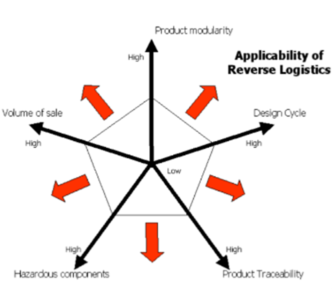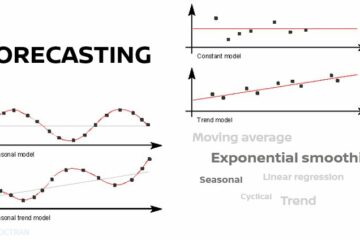Reverse Logistics and how companies have implemented it? (Part 2)

In the previous blog, we have discussed the reverse logistics process and gone through a very informative case study of Amazon. You are welcome to read it (again) here. In this blog, it comes to the question of which products are suitable for these activities in reverse logistics? Payaro (n.d.) established a product characteristics model identifying the level of recovery of a product. According to the model, the seven product features (see Figure 1 above) should be taken into account, which are:
- Product size: indicates the approximate dimensions of a good and its weight. When a product has large dimensions, it is difficult for consumers to transport it to the collection center, placing a constraint on the reverse logistics, in which the company should consider and seek for a feasible return policy (e.g. trade in, pickup system, take back, etc.).
- Volume of sale: represent the number of products sold.
- Hazardous components: means that a product has a large environmental impact at end-of-life. There are considerable amounts of toxic and potentially hazardous waste material in electronics and computers. A product containing a high percentage of hazardous components must be recovered in a proper manner that is safe to the workers and the environment.
- Design cycle and product life cycle: specifies the length of time between successive generations of the product. In other words, it shows how frequent a design team redesigns the product or creates a new one thus making the original product obsolete. This element is critical as a long-life cycle allows the product to be recovered, checked and re-inserted components in new products, which leads to a lower obsolescence than a short-life cycle product.
- Product traceability: demonstrates the traceability systems that record that path of an article (e.g. components) from suppliers, through all the intermediate steps which process and assemble components into new products, and through the supply chain to customers. Therefore, a high level of traceability allows to identify the consumer, thus adapting solutions to stimulate him to update his purchase. For example, Fairphone, a Dutch social enterprise company, sells smartphone that can be upgraded to next generation by changing components.
- Product modularity: modularity is an approach of decomposing and recombining components, aiming for organizing complex products and processes efficiently. In this case, engineers must embed strategic modularity into the product to enhance component reuse/ material cycle while reducing costs to recycling companies.
Now, let’s discover how companies have been considering these factors into formulating their reverse logistics policies.
#1: Zappos’s 365 return policy
The e-commerce shoes and apparel seller, which is located in the US, is known for its return policy extending up to 365 days. The returns must be unworn with the original tags attached and original packaging. To simplify the reverse logistics processes, Zappos focuses on products of a certain type and within a specific range of weight and volume. Besides, there are three key return options, including printer-free returns to UPS, UPS Pickups and UPS drop-off (self-label printing). Together with clear information about return policy on their website, it enables customers to have more confidence to keep purchasing at Zappos. Apart from that, the seller also suggests customers exchange an eligible item instead of returning to maintain sales occurred during the return process.
#2: Electronics’ Reverse Logistics Systems in Brazil
Since only 1% of used battery were recycled or disposed correctly in Brazil, the government decided to set rules for return hazardous components in many industry sectors in 2011 (Bruha, 2015). The reverse logistics process starts with collection when users return used battery to more than 1,000 pickup points throughout Brazil’s state capital and larger cites. Once there are more than 30kg of used battery at the pickup point, the location is responsible for calling the contracted logistics company GM&C, which will transport the battery to the place for disposal or recycling. Costs of the reverse logistics processes are determined in two ways: manufacturers and importers of batteries associated with ABINEE*, and those are not. The companies participating in the ABINEE program determine the cost themselves, while the other group will be notified the incurred costs and procedures by ABINEE and IBAMA**.
*ABINEE: the Brazilian Association of the Electronics Industries
**IBAMA: the Federal Police, the Federal Revenue Service and the Ministry of Environment
Besides these two case studies, you can find out other case studies in different industries and processed in the Table 1 below by de Brito et al. (2002). The table tells a very interesting story summarizing what kind of product/components have been going through reverse logistics process, what was the transformation process and its outputs, the actors being responsible for this process and who can stimulate the process. It is a concrete overview of categorizing multiple factors during reverse logistics, separating from distinct industries such as IT, Inventory Management, Planning and Control, etc. More information could be retrieved by searching “Reverse logistics: a review of case studies”.
Table 1: Case studies with focus on the Information Technology (de Brito et al., 2002)

Thank you for reading and please share if you think it’s useful! See you in the next blog!
Recommended reading:
Reverse Logistics: a review of case studies (de Brito et al., 2002)
https://www.zappos.com/c/shipping-and-returns
http://www.payaro.com/documents/Reverse%20logistics%20and%20RFID_payaro_2.PDF
www.logisticsbureau.com/reverse-logistics-who-does-it-well/
https://thebrazilbusiness.com/article/reverse-logistics-for-batteries-in-brazil
https://shop.fairphone.com/en/recycle?ref=footer
Series “Reverse logistics”
-
Reverse Logistics and how companies have implemented it? (Part 2)
Reverse Logistics and how companies have implemented it (Part 2)
-
Digital technology in reverse logistics
How to benefit from reverse logistics and digital technologies such as Radio Frequency Identification, Blockchain, Cloud computing and Artificial Intelligence (AI).
-
Reverse Logistics and how companies have implemented it? (Part 1)
Reverse Logistics: a case study on Amazon return policy


0 Comments